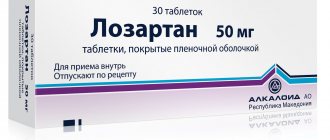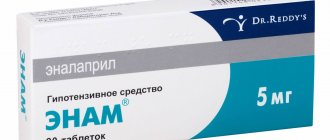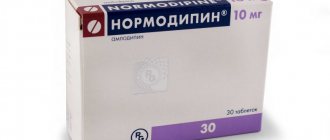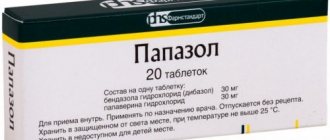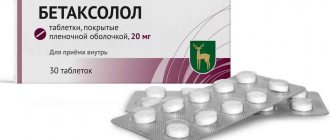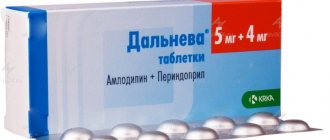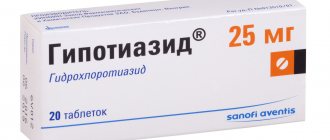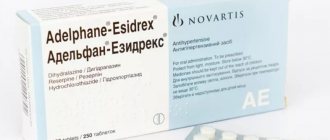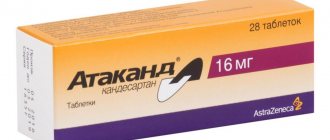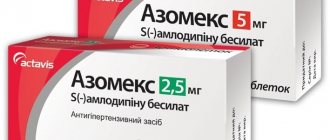Release form
Monopril is a white, round, biconvex, odorless tablet, scored on one edge and engraved “609” or “158” on the other.
Available according to:
- 14 such tablets of 20 mg in a blister, two blisters in a paper pack;
- 10 such tablets of 10 mg each in a blister made of plastic and aluminum foil, one or two blisters in a paper pack;
- 14 such tablets of 10 mg each in a blister made of plastic and aluminum foil, one or two blisters in a paper pack.
Pharmacodynamics and pharmacokinetics
Pharmacodynamics
Angiotensin-converting enzyme inhibitor. Chemically, fosinopril sodium is the sodium salt of fosinoprilat ester. Fosinoprilat is a selective competitive angiotensin-converting enzyme . After inhibiting ACE, it prevents the transformation of angiotensin type 1 into angiotensin type 2, which has a vasopressor effect. This leads to a decrease in the content angiotensin in the blood - this causes a decrease in its vasoconstrictor activity and a weakening of aldosterone .
Fosinoprilat inhibits the metabolism of bradykinin and therefore its antihypertensive effect is enhanced. The decrease in pressure is not accompanied by a decrease or increase in circulating blood volume, renal and cerebral blood flow, or blood supply to organs. After internal administration, the antihypertensive effect occurs within one hour, becomes maximum after 2-5 hours and lasts up to a day. Several weeks are necessary to achieve the greatest therapeutic effect.
The antihypertensive effects of thiazide diuretics and fosinopril are complementary.
The drug helps reduce sensitivity to physical activity and reduce the severity of heart failure.
Pharmacokinetics
After oral administration, absorption from the intestine reaches 30-40% and does not depend on food intake. Maximum plasma concentration occurs after three hours. Interaction with blood proteins reaches 95%.
Enzymatic hydrolysis of the drug occurs in the liver and intestinal mucosa. Fosinoprilat is excreted equally through the digestive tract and kidneys. The half-life is close to 11 hours.
Instructions:
Clinical and pharmacological group
01.024 (ACE inhibitor)
Release form, composition and packaging
The tablets are round, biconvex, white or almost white, practically odorless, scored on one side and engraved “158” on the other side.
| 1 tab. | |
| fosinopril sodium | 10 mg |
Excipients: anhydrous lactose, microcrystalline cellulose, crospovidone, polyvinylpyrrolidine, sodium stearyl fumarate.
10 pieces. - blisters made of polyvinylidene chloride and aluminum foil (1) - cardboard packs. 10 pcs. - blisters made of polyvinylidene chloride and aluminum foil (2) - cardboard packs. 14 pcs. - blisters made of polyvinylidene chloride and aluminum foil (1) - cardboard packs. 14 pcs. - blisters made of polyvinylidene chloride and aluminum foil (2) - cardboard packs.
The tablets are round, biconvex, white or almost white, practically odorless, scored on one side and engraved “609” on the other side.
| 1 tab. | |
| fosinopril sodium | 20 mg |
Excipients: anhydrous lactose, microcrystalline cellulose, crospovidone, polyvinylpyrrolidine, sodium stearyl fumarate.
10 pieces. - blisters made of polyvinylidene chloride and aluminum foil (1) - cardboard packs. 10 pcs. - blisters made of polyvinylidene chloride and aluminum foil (2) - cardboard packs. 14 pcs. - blisters made of polyvinylidene chloride and aluminum foil (1) - cardboard packs. 14 pcs. - blisters made of polyvinylidene chloride and aluminum foil (2) - cardboard packs.
pharmachologic effect
ACE inhibitor. Fosinopril is an ester from which the active compound fosinoprilat is formed in the body as a result of hydrolysis under the action of esterases.
Fosinopril, due to the specific connection of the phosphate group with ACE, prevents the conversion of angiotensin I into the vasoconstrictor substance angiotensin II, as a result of which vasopressor activity and aldosterone secretion are reduced. The latter effect can lead to a slight increase in the content of potassium ions in the serum (average 0.1 mEq/L) with a simultaneous loss of sodium ions and fluid from the body.
Fosinopril suppresses the metabolic degradation of bradykinin, which has a powerful vasopressor effect; Due to this, the antihypertensive effect of the drug may be enhanced.
A decrease in blood pressure is not accompanied by changes in blood volume, cerebral and renal blood flow, blood supply to internal organs, skeletal muscles, skin, or reflex activity of the myocardium. After oral administration, the hypotensive effect develops within 1 hour, reaches a maximum after 3-6 hours and persists for 24 hours.
In heart failure, the positive effects of Monopril are achieved mainly through suppression of the renin-aldosterone system. Suppression of ACE leads to a decrease in both preload and afterload on the myocardium.
The drug helps to increase tolerance to physical activity and reduce the severity of heart failure.
Pharmacokinetics
Suction
After oral administration, absorption from the gastrointestinal tract is about 30-40%. The extent of absorption is independent of food intake, but the rate of absorption may be slow. Cmax of fosinoprilat in plasma is achieved after 3 hours and does not depend on the dose taken.
Distribution
Plasma protein binding is ≥95%. Fosinoprilat has a relatively small Vd and is only slightly associated with cellular components of the blood.
Metabolism
Hydrolysis of fosinopril under the action of enzymes with the formation of fosinoprilat occurs mainly in the liver and gastrointestinal mucosa.
Removal
Fosinopril is excreted from the body equally by the kidneys and the liver. For arterial hypertension in patients with normal renal and liver function, T1/2 of fosinoprilat is about 11.5 hours. For heart failure, T1/2 is 14 hours.
Pharmacokinetics in special clinical situations
In patients with impaired renal function (creatinine clearance <80 ml/min/1.73 m2), the total clearance of fosinoprilat from the body is approximately half that of patients with normal renal function. At the same time, absorption, bioavailability and protein binding are not noticeably changed. Reduced excretion by the kidneys is compensated by increased excretion by the liver. A moderate increase in plasma AUC values (less than double the normal value) was observed in patients with varying degrees of renal failure, including end-stage renal failure (creatinine clearance <10 ml/min/1.73 m2).
The clearance of fosinoprilat during hemodialysis and peritoneal dialysis averages 2% and 7% (relative to urea clearance values), respectively.
In patients with impaired liver function (with alcoholic or biliary cirrhosis), the rate of hydrolysis of fosinopril may be reduced without significant changes in its degree. The total clearance of fosinoprilat from the body of such patients is approximately half that of patients with normal liver function.
Dosage
The drug is prescribed orally. The dose is set individually.
For arterial hypertension, the recommended initial dose is 10 mg 1 time / day. The dose should be selected depending on the dynamics of blood pressure reduction. Doses vary from 10 to 40 mg 1 time / day. In the absence of a sufficient hypotensive effect, additional diuretics may be prescribed.
If treatment with Monopril is started against the background of diuretic therapy, then its initial dose should be no more than 10 mg with careful medical monitoring of the patient’s condition.
For chronic heart failure, the recommended initial dose is 5 mg 1 or 2 times a day. Depending on the therapeutic effectiveness, the dose can be increased at weekly intervals, increasing it to a maximum of 40 mg 1 time / day.
Since fosinopril is eliminated from the body in two ways, a dose reduction of Monopril is usually not required when treating arterial hypertension and heart failure in patients with impaired renal or hepatic function.
There are no differences in the effectiveness and safety of treatment with Monopril in patients aged 65 years and older and young patients. However, in older patients, greater susceptibility to the drug cannot be ruled out due to possible overdose events due to slow elimination of the drug.
Overdose
Symptoms: marked decrease in blood pressure, bradycardia, shock, impaired fluid and electrolyte status, acute renal failure, stupor.
Treatment: the drug should be stopped, gastric lavage, sorbents (for example, activated carbon), vasopressors, infusion of 0.9% sodium chloride solution, and then symptomatic and supportive treatment are indicated. The use of hemodialysis is ineffective.
Drug interactions
The simultaneous use of antacids (including aluminum hydroxide, magnesium hydroxide, simethicone) may reduce the absorption of fosinopril (Monopril and these drugs should be taken at least 2 hours apart).
In patients receiving Monopril simultaneously with lithium salts, there may be an increase in the concentration of lithium in the blood plasma and the risk of developing lithium intoxication (use with caution at the same time).
When prescribing Monopril, it should be taken into account that indomethacin and other NSAIDs (including acetylsalicylic acid) may reduce the antihypertensive effect of ACE inhibitors, especially in patients with low-renin hypertension.
When using Monopril together with diuretics or in combination with a strict diet that limits salt intake, or with dialysis, severe arterial hypotension may develop, especially in the first hour after taking the initial dose of fosinopril.
When Monopril is used together with potassium preparations, potassium-sparing diuretics (including amiloride, spironolactone, triamterene), with food additives containing potassium, the risk of developing hyperkalemia increases. In patients with heart failure, diabetes mellitus, and concomitantly taking potassium-sparing diuretics, potassium-containing salt substitutes, or other drugs that cause hyperkalemia (for example, heparin), ACE inhibitors increase the risk of increasing the concentration of potassium ions in the blood serum.
Fosinopril enhances the hypoglycemic effect of sulfonylurea derivatives and insulin.
When used simultaneously with allopurinol, cytostatic agents, immunosuppressants, procainamide, there is a risk of developing leukopenia.
Estrogens weaken the hypotensive effect of Monopril due to its ability to retain water.
Antihypertensive drugs, opioid analgesics, drugs for general anesthesia enhance the hypotensive effect of Monopril.
The bioavailability of fosinopril when used simultaneously with chlorthalidone, nifedipine, propranolol, hydrochlorothiazide, cimetidine, metoclopramide, propantheline bromide, digoxin, acetylsalicylic acid and warfarin does not change.
Use during pregnancy and lactation
Monopril is contraindicated during pregnancy. Use of the drug in the second and third trimesters of pregnancy causes damage or death to the developing fetus. Since fosinoprilat is excreted in breast milk, if it is necessary to use Monopril during lactation, breastfeeding should be discontinued.
For newborns whose mothers took ACE inhibitors during pregnancy, it is recommended to carefully monitor them for timely detection of arterial hypotension, oliguria and hyperkalemia.
Side effects
From the cardiovascular system: decreased blood pressure, orthostatic collapse, tachycardia, palpitations, arrhythmia, angina pectoris, myocardial infarction, flushes of blood to the facial skin, hypertensive crisis, cardiac arrest, fainting.
From the urinary system: development or worsening of symptoms of chronic renal failure, proteinuria, disorders of the prostate gland.
From the central nervous system and peripheral nervous system: stroke, cerebral ischemia, dizziness, headache, weakness, memory impairment; when used in high doses - insomnia, anxiety, depression, confusion, drowsiness, paresthesia.
From the senses: hearing and vision impairment, tinnitus.
From the digestive system: nausea, diarrhea, intestinal obstruction, pancreatitis, hepatitis, cholestatic jaundice, abdominal pain, vomiting, constipation, anorexia, stomatitis, glossitis, dysphagia, flatulence, loss of appetite, changes in body weight, dry mouth.
From the respiratory system: dry cough, pulmonary infiltrates, bronchospasm, shortness of breath, rhinorrhea, pharyngitis, dysphonia, nosebleeds.
From the hematopoietic organs: lymphadenitis.
From the musculoskeletal system: arthritis.
Metabolism: gout.
Allergic reactions: skin rash, itching, angioedema.
From laboratory parameters: hypercreatininemia, increased urea concentration, increased activity of liver transaminases, hyperbilirubinemia, hyperkalemia, hyponatremia; decreased hemoglobin concentration and hematocrit, increased ESR, leukopenia, neutropenia, eosinophilia.
Effect on the fetus: impaired development of the fetal kidneys, decreased blood pressure in the fetus and newborns, impaired renal function, hyperkalemia, hypoplasia of the skull bones, oligohydramnios, contractures of the limbs, pulmonary hypoplasia.
Storage conditions and periods
The drug should be stored out of the reach of children, in a dry place at a temperature of 15° to 25°C. Shelf life: 3 years.
Indications
- arterial hypertension (for monotherapy or as part of combination therapy, in particular with thiazide diuretics);
- heart failure (as part of combination therapy).
Contraindications
- history of angioedema (including the use of other ACE inhibitors);
- pregnancy;
- lactation (breastfeeding);
- age under 18 years (efficacy and safety have not been established);
- hypersensitivity to fosinopril and other components of the drug.
Use with caution in renal failure; hyponatremia (risk of dehydration, arterial hypotension, chronic renal failure); bilateral renal artery stenosis or stenosis of the artery of a single kidney; aortic stenosis; condition after kidney transplantation; during desensitization; systemic connective tissue diseases (including SLE, scleroderma) due to an increased risk of developing neutropenia or agranulocytosis; during hemodialysis; for cerebrovascular diseases (including cerebrovascular insufficiency); IHD; chronic heart failure of III-IV functional class (NYHA classification); for diabetes mellitus; inhibition of bone marrow hematopoiesis; hyperkalemia; in elderly patients; for gout, on a diet with limited salt; in conditions accompanied by a decrease in blood volume (including diarrhea, vomiting, previous treatment with diuretics).
special instructions
Before starting treatment, it is necessary to analyze previous antihypertensive therapy, the degree of increase in blood pressure, dietary restrictions on salt and/or liquid, and other clinical circumstances.
If possible, previous antihypertensive treatment should be discontinued several days before starting treatment with Monopril.
To reduce the likelihood of arterial hypotension, diuretics should be discontinued 2-3 days before starting treatment with Monopril.
Before and during treatment, it is necessary to monitor blood pressure, renal function, the content of potassium ions, creatinine, urea, electrolyte concentrations and the activity of liver enzymes in the blood.
The development of angioedema has been reported in patients taking Monopril. Swelling of the tongue, pharynx, or larynx can cause airway obstruction, which can be fatal. If such reactions develop, patients must stop taking the drug and take emergency treatment measures, incl. subcutaneous injection of epinephrine (adrenaline) solution (1:1000).
Swelling of the intestinal mucosa has rarely been observed while taking ACE inhibitors. In such cases, patients complained of abdominal pain (there may have been no nausea and vomiting); in some cases, swelling of the intestinal mucosa occurred without swelling of the face; the level of C1-esterases was normal. Symptoms disappeared after stopping the use of ACE inhibitors. Swelling of the intestinal mucosa should be taken into account in the differential diagnosis of patients with complaints of abdominal pain during treatment with ACE inhibitors.
During therapy with ACE inhibitors, anaphylactic reactions may develop during hemodialysis through highly permeable membranes, as well as during LDL apheresis with adsorption on dextran sulfate. In such cases, the use of a different type of dialysis membrane or other drug treatment should be considered.
It is possible to develop agranulocytosis and suppression of bone marrow function during treatment with ACE inhibitors. These cases occur more often in patients with impaired renal function, especially in the presence of systemic connective tissue diseases (systemic lupus erythematosus or scleroderma). Before starting therapy with ACE inhibitors and during treatment, the total number of leukocytes and the leukocyte formula are determined (once a month in the first 3-6 months of treatment and in the first year of using the drug in patients with an increased risk of neutropenia).
In patients with uncomplicated arterial hypertension, arterial hypotension may develop due to the use of the drug Monopril.
Symptomatic hypotension with the use of ACE inhibitors most often develops in patients after intensive treatment with diuretics, a salt-restricted diet, or during renal dialysis. Temporary arterial hypotension is not a contraindication for the use of the drug after taking measures to hydrate the body.
In patients with chronic heart failure, treatment with ACE inhibitors may cause excessive antihypertensive effects, which can lead to oliguria or azotemia, which can be fatal. Therefore, when treating chronic heart failure with Monopril, it is necessary to carefully monitor patients, especially during the first 2 weeks of treatment, as well as with any increase in the dose of Monopril or a diuretic.
A reduction in the diuretic dose may be required in patients with hyponatremia and in patients previously intensively treated with diuretics. Arterial hypotension is not a contraindication for further use of the drug Monopril. Some reduction in systemic blood pressure is a common and desirable effect when starting the drug for heart failure. The degree of this reduction is maximum in the early stages of treatment and stabilizes within 1-2 weeks from the start of treatment. Blood pressure usually returns to pre-treatment values without a decrease in therapeutic efficacy.
If noticeable jaundice appears and a marked increase in the activity of liver enzymes, treatment with Monopril should be discontinued and appropriate treatment should be prescribed.
In patients with arterial hypertension with bilateral renal artery stenosis or stenosis of the artery of a single kidney, as well as with the simultaneous use of diuretics without signs of renal vascular disease, the concentration of blood urea nitrogen and serum creatinine may increase during treatment with ACE inhibitors. These effects are usually reversible and disappear after treatment is stopped. It may be necessary to reduce the dose of diuretic and/or Monopril.
In patients with severe chronic heart failure, with altered activity of the renin-angiotensin-aldosterone system, treatment with ACE inhibitors can lead to oliguria, progressive azotemia and, in rare cases, acute renal failure and possible death.
ACE inhibitors may enhance the hypotensive effect of drugs used for general anesthesia. Before surgery (including dentistry), you must warn your doctor about the use of ACE inhibitors.
Caution should be exercised when performing physical exercise or in hot weather due to the risk of dehydration and hypotension due to a decrease in blood volume.
Impact on the ability to drive vehicles and operate machinery
Care must be taken when driving vehicles or performing other work that requires increased attention, because dizziness may develop, especially after taking the initial dose of an ACE inhibitor in patients taking diuretics.
Use for renal impairment
Use with caution in renal failure, bilateral renal artery stenosis or stenosis of the artery of a single kidney, condition after kidney transplantation, and hemodialysis.
Use for liver dysfunction
If noticeable jaundice appears and a marked increase in the activity of liver enzymes, treatment with Monopril should be discontinued and appropriate treatment should be prescribed.
Conditions for dispensing from pharmacies
The drug is available with a prescription.
Contraindications
- Quincke's edema.
- Hypersensitivity to any of the components of the drug.
- Age up to 18 years.
- Pregnancy or lactation.
Use with caution when:
- hyponatremia;
- bipolar renal artery stenosis ;
- desensitization;
- aortic stenosis;
- condition after kidney transplantation;
- renal failure;
- systemic connective tissue lesions;
- hemodialysis;
- cerebrovascular diseases;
- coronary heart disease ; heart failure of the chronic type 3–4 degrees;
- diabetes mellitus;
- hyperkalemia;
- inhibition of hematopoiesis in the bone marrow;
- gout;
- in old age;
- conditions accompanied by a decrease in circulating blood volume.
What to replace, what is better?
From time to time, a problem arises regarding the drug Monopril - how to replace the drug in the case of:
- occurrence of undesirable effects;
- lack of positive dynamics in therapy;
- presence of contraindications;
- considerable cost of the medicine.
There are analogues in the pharmacological group and an analogue in the active substance, as mentioned above. Let's look at some options below.
Perindopril
The choice of drug - Monopril or Perindopril - is necessary for a patient for whom one or another medicine ceases to help fully.
Perindopril is the same as Monopril tablets:
- belongs to the group of ACE inhibitors;
- prescribed for high blood pressure and heart failure.
A distinctive feature of the drug Perindopril can be considered:
- undesirable use for severe hypertension;
- special attention should be taken in case of kidney dysfunction.
Fosinopril
Fosinopril tablets, produced by Izvarino Pharma (Russia), are one of the analogues of the drug Monopril in terms of the main active ingredient. And everyone should choose Monopril or Fosinopril for themselves, taking into account the differences:
- country and manufacturer;
- drug prices.
Since the indications, contraindications and side effects of these two drugs are similar.
Enalapril
Only a doctor should decide the dilemma - Monopril or Enalapril, which of these drugs is better for a particular patient. Enalapril is an analogue of the drug Monopril according to the pharmaceutical group.
These drugs are similar:
- indications for use;
- restrictions;
- adverse events.
At the same time, it is advisable to take Enalapril with caution when taking the drug in the following persons:
- in patients with reduced circulating blood volume due to: low-salt and salt-free diets;
- diuretic treatment;
- hemodialysis;
- chronic diarrhea;
- profuse vomiting;
Before deciding on a specific drug, you should consult your doctor.
Side effects
The most likely side effects of Monopril.
- From the circulatory system: chest pain, fainting, orthostatic hypotension , hot flashes, arrhythmia .
- Digestive disorders: vomiting, dyspepsia, pancreatitis ALT and AST levels , hepatitis .
- From the nervous system: sensory disturbances, feeling of fatigue.
- From the genitourinary system: oliguria, proteinuria , increased concentrations of creatinine and urea .
- From the respiratory system: sinusitis, pharyngitis , cough, bronchospasm .
- From the musculoskeletal system: pain in joints and muscles.
- Allergic reactions: photosensitivity , itching , rash , Quincke's edema .
Instructions for use of Monopril (Method and dosage)
Instructions for use of Monopril recommend taking the drug orally. The dosage is selected individually.
Arterial hypertension . The initial dose is 10 mg once a day. It is necessary to select the dose by observing the dynamics of pressure reduction. The standard dose ranges from 11-40 mg once daily. If there is no sufficient hypotensive effect, additional diuretics .
Heart failure . The initial dose is 5 mg up to two times a day. Over time, the dose can be increased to 40 mg per day.
Special instructions and recommendations
Treatment with the drug Monopril for high blood pressure is necessary after examination, tests and determination of the cause of hypertension. The decision to prescribe tablets is made by the attending physician. When prescribing the drug, the doctor takes into account which blood pressure pills the patient took before and gives recommendations for lifestyle correction. It is necessary to reduce salt intake.
When taking Monopril to lower blood pressure, you must follow the recommendations and special instructions in order to obtain the maximum therapeutic effect and reduce the likelihood of adverse reactions:
- a few days before starting therapy with Monopril, you must stop taking other antihypertensive drugs;
- 2-3 days before starting Monopril use, stop drinking diuretics to reduce the risk of a sharp drop in blood pressure to critical values;
- when taking Monopril, it is necessary to constantly monitor blood pressure, monitor kidney function, creatinine, potassium ions, venous blood, electrolytes, and monitor the activity of liver enzymes;
- if allergic reactions occur due to the prescription of Monopril, you must stop taking the tablets;
- the use of ACE inhibitor tablets can cause swelling of the larynx and intestines; if you experience abdominal pain or other signs of swelling, you should consult a doctor and stop taking Monopril;
- if allergic reactions or angioedema occur due to Monopril, you must stop taking the tablets and consult a doctor who will select other antihypertensive medications;
- before using angiotensin-converting enzyme inhibitors and throughout the entire course of therapy, it is necessary to monitor the level of leukocytes, do a leukogram to eliminate the risk of suppression of bone marrow function and a sharp decrease in the level of leukocytes;
- The doctor takes patients with relative contraindications under special control and constantly monitors the performance of internal organs and vital systems;
- when undergoing dialysis, taking diuretics, or following a salt-free diet, the likelihood of a strong decrease in blood pressure increases;
- Angiotensin-converting enzyme inhibitors are recommended for patients with chronic heart failure, but the doctor must monitor such patients to eliminate the risk of a strong decrease in blood pressure, an increase in nitrogenous metabolic products, and a decrease in the volume of urine produced;
- when increasing the dosage in patients with heart failure, it is necessary to monitor the patient’s condition for the first two weeks;
- a slight decrease in blood pressure at the beginning of therapy with Monopril for CHF is normal; the maximum effect of taking the medication is achieved 7-14 days after the start of therapy;
- when taking Monopril, the patient may develop cholestatic jaundice, which can develop into liver necrosis with a fatal outcome; doctors recommend monitoring liver enzyme levels and if there is a slight increase in values, stop taking Monopril;
- in case of liver failure, the level of fosinopril in the blood may increase, so patients require dose adjustment;
- in patients with arterial stenosis of the kidney, taking an ACE inhibitor may lead to an increase in the level of creatinine in the blood, in which case it is necessary to stop taking the medication and consult a doctor;
- patients with impaired renal function should take the blood pressure drug Monopril with extreme caution; it is necessary to monitor the patient’s condition for the first 14 days from the start of treatment;
- taking Monopril for CHF can lead to an increased level of nitrogenous metabolic products in the blood, a decrease in urine formation, and the likelihood of death due to kidney failure increases;
- when taking Monopril for high blood pressure by diabetics and patients with kidney failure, the risk of potassium excess increases;
- hyperkalemia can develop while taking tablets in patients undergoing therapy with potassium-containing drugs or diuretic tablets.
If the patient develops a severe cough, it is necessary to inform the doctor about taking Monopril. It is imperative to warn the anesthesiologist before surgery about taking Monopril.
Taking Monopril causes inhibition and deterioration of psychomotor reactions, so the patient should refrain from performing hard work that requires increased concentration.
When taking Monopril, work that requires increased attention may be difficult
Overdose
Signs: severe decrease in blood pressure, bradycardia, shock , water-mineral imbalance, acute renal failure, stupor.
Therapy: stop taking Monopril, gastric lavage, use of sorbents, vasopressors , intravenous saline, then symptomatic and supportive therapy. Hemodialysis is ineffective.
Pregnancy and breastfeeding period
Monopril for hypertension should not be taken during pregnancy. In the second or third trimester, taking the medication can lead to severe internal pathologies or fetal death.
If a woman finds out she is pregnant while undergoing treatment with Monopril, she must immediately stop taking the drug. The doctor should warn the pregnant woman about possible pathologies and the negative effects of the pills on the fetus. After discontinuation of the drug, an additional examination of the pregnant woman is carried out to exclude a negative effect on the intrauterine development of the fetus.
If oligohydramnios is detected, Monopril is discontinued. The doctor may leave the pills during pregnancy or during oligohydramnios, if the risk to the health and life of the mother outweighs the possible negative consequences for the child.
If a pregnant woman took an ACE inhibitor during gestation, the child may have congenital pathologies: excess potassium in the blood, a decrease in the amount of urine excreted by the kidneys, low blood pressure. Infants should be under special supervision by a doctor during the first days of life. If oliguria is detected, the doctor monitors blood pressure readings and performs renal perfusion. To normalize blood pressure, your doctor may give blood transfusions and dialysis. Hemodialysis is not performed on newborns.
The components of Monopril pass into breast milk, so the tablets should not be taken while breastfeeding a baby. If Monopril therapy cannot be excluded, the woman should stop breastfeeding.
Interaction
Concomitant use with antacids reduces the absorption of fosinopril , so they should be taken at intervals of 2 hours.
When used together with lithium salts, lithium intoxication increases .
Nonsteroidal anti-inflammatory drugs suppress the antihypertensive effect of Monopril and similar drugs.
When using the drug simultaneously with diuretics, an excessive decrease in blood pressure may develop.
Drugs containing potassium and potassium-sparing diuretics increase the likelihood of developing hyperkalemia .
Fosinopril activates the hypoglycemic effect of insulin and sulfonylurea ; increases the risk of leukopenia when used with cytostatic agents, immunosuppressants, Allopurinol, Procainamide.
Estrogens suppress the antihypertensive effect of Monopril.
Patient reviews
How can you start taking Monopril without reading reviews from patients who have used it? It must be said that for Monopril tablets the reviews are somewhat ambiguous.
Some patients claim:
- has a mild hypotensive effect;
- reduces hypertensive crises.
At the same time, a number of patients note:
- the manifestation of side effects in the form of hot flashes, constipation, sleep disturbances, headaches and the appearance of arrhythmia while taking the Monopril tablet;
- high cost of medicine;
- insufficient blood pressure reduction with monotherapy.
According to reviews from patients taking the drug Monopril, domestic analogues are in no way inferior to those of the imported manufacturer. And in some places they even win when it comes to price.
Analogues of Monopril
Level 4 ATC code matches:
Dilaprel
Prenesa
Enap
Diroton
Lipril
Renipril
Parnavel
Fozinap
Tritace
Enam
Zokardis
Fosinopril
Lisinopril
Captopril
Renitek
Hartil
Phosicard
Amprilan
Ramipril
Perindopril
The most common analogues of Monopril: Fosicard , Fosinap, Fozinotec, Fosinopril-Teva.
Monopril price, where to buy
The price of Monopril 20 mg No. 28 in Russia fluctuates around 309-430 rubles, in Ukraine – 173-273 hryvnia.
- Online pharmacies in RussiaRussia
ZdravCity
- Monopril tablets 20 mg 28 pcs. Bristol Myers Squibb CpL/ICN Polfa Rzeszow SA
502 rub. order
